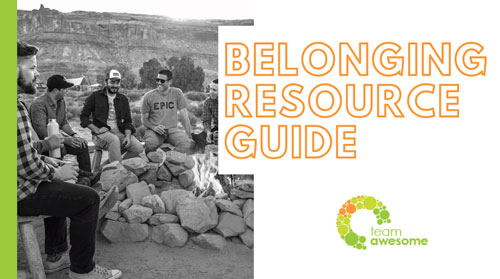For decades, we have talked about the need for our organizational cultures to enable the engagement of its employees. If you haven’t seen the value in that yet, we may have bigger problems on our hands. But assuming you are on that boat, another way of considering engagement is not looking at it from a sense of engagement in the work, but from the perspective of seeking belonging in a community.
This is not the first time I have argued the value of belonging. Previously I discussed using good communication as a means to create belonging, rather than leaving employees out of critical information. There are countless opportunities to create a sense of belonging in your organization, and communication is simply one way to do that. And on a day-to-day basis, that is all that culture is. A collection of teeny-tiny moments that add up to a feeling. Culture is the cumulation of every small decision you make as a leader, how it is perceived, and how you represent yours and the company’s values at every small opportunity to do so (whether you are consciously choosing to or not).
Outliers
The inverse of feeling belonging is feeling like an outlier. It doesn’t always have to be black and white (as emotions never are), where you either feel entirely part of a group or not. It usually presents itself in much subtler gray tones. Perhaps you love your company and coworkers, but some part of you notices that you are the only woman in the board room. Maybe you are in a meeting with a group of people who like to talk things out as they go, rather than having planned an agenda as you would do. Sometimes addressing outliers and belonging is as obvious as the inclusion efforts for people of color, LGBTQ employees, young people, old people, you name it.
If we listened closely enough, we would be amazed to discover the larger subculture of outliers. Banded together by the mutual experience of feeling like “the other,” we begin to question what is true for us. Because what is true for us seems to go against the grain of what is true for everyone else. We have all felt this at some point in our lives. We’ve questioned what was happening around us or if we were in the right place, with the right people. We have felt out of alignment with ourselves, but couldn’t quite place why that was. In most of these cases, that feeling of misalignment you feel as an outlier is rooted in being at odds with something you value. If you feel a sense of belonging, then all of the important parts of you, your values, are generally being honored.
Sense of Belonging
For companies looking to retain their talent resources, we have to take a mental picture of what belonging feels like, and what it feels like to be the outlier. And then, bridge the gap for the humans with whom we spend our days. Not sure who might feel like an outlier? Here’s a list of possible scenarios that go beyond race, color, gender and sexual orientation to get your brainstorming started:
- Introverts around pontificators
- Questioners around “yes” people
- Young, high-potential leaders in a “this is how we’ve always done it” culture
- Salespeople around creatives
- Seasoned employees around a Millennial-aged workforce
- Foreign-born students in American universities
- Parents around non-parents (and vice versa)
Think of it as a club that you can only be in based on something you can’t change about yourself. People feel belonging when they feel heard and understood for who they are at the core of themselves, and cannot change. I will always be an introvert, a parent, and a woman, and these have all been both a source of belonging and feeling like an outlier for me.
Your Next Move
As a leader, here are a few questions to help you do just that:
- When do you feel like an outlier?
- What are some situations when others around you may feel like the outlier?
- How can you create a sense of belonging for those on your team?
Once you have an emotional understanding of where you are, and where you want to go you can begin to make small but frequent changes to encourage a sense of belonging on your team. Remember, culture and belonging is made of a collection of small moments, not one event you can check off of a list. They have to be micro-small, consistent changes made over time. Here are a few ideas to consider for creating belonging on your team:
- Walk life milestones together: Celebrate babies, birthdays, weddings and soberversaries. Band together over funerals, breakups and hard stuff. People will only share these with the group when they feel safe to do so.
- Learn a lot about your team: Learn what they like, what frustrates them, how they work best, and how they respond to stress. Share the same about you with them. Choose actions that create an optimal environment for your fellow humans.
- Drop any judgement: Ask your team where they do and do not find belonging from their perspective, and ask about their experiences. Listen without attaching and right or wrong, good or bad to their responses, simply learn a new perspective.
You’ve experienced what it feels like to be an outlier. But have you identified when you have caused that experience for someone else? What small changes can you make to create belonging and an inclusive environment for your team? After all, it’s just a series of tiny decisions and actions.
About the author:
Katie Rasoul is the Chief Awesome Officer for Team Awesome, a leadership coaching and culture consulting firm. Find out more by visiting www.teamawesomecoaching.com or sign up for our mailing list for awesomeness coming straight to your inbox. Follow Team Awesome on Facebook and Twitter.



I am an introvert and I have OCD. Both affect how I talk to people. I have always had trouble talking to people, sobI just don’t try. But I really want to be social. Is there something wrong with me?
Thanks for the note, Rebekah. There is not anything wrong with you. It makes sense that talking to people might take some creative solutions for you. It is okay to try and find ways that work for you, and it is worth the effort. I commend you for your interest to connect with others. Try researching and experimenting with small steps that you could take to connect with others. Maybe a specific Facebook group or meetup that matches your interests? Or starting with smaller gatherings that feel more approachable, and less overwhelming. Keep trying, even when the progress is small. You’ve got this.